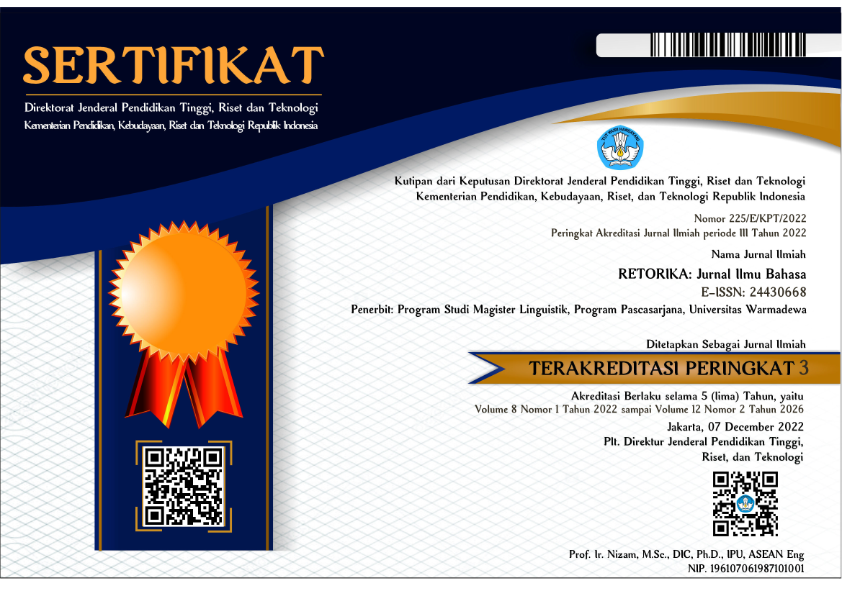Possessive Construction in Uab Meto
Abstract
This paper is a result of research which is aimed to uncover the structure and marking on the possessive construction in Uab Meto based on morpho-syntax point of view. The data collected for this research were classified into the primary data (observation) and the secondary data (the data that are obtained from texts). The technique employed to analyze the data was descriptive-analytic, and the approach applied was deductive-inductive. The result of the research shows that in Uab Meto, predicative possession is expressed through the verb muiÉ â€˜have/has’. In some usages, muiÉ metathezised to muÉi. Possesive construction of Uab Meto is also applied topicalization strategy, and the last is using a verbal prefix ma-. This prefix ma- is a verbal prefix because it carries a verbal meaning, that is have/has. Furthermore, there are two attributive possessive constructions, namely juxtaposed construction. The possessor in juxtaposed constructions can be a noun or pronoun. The second attributive possessive is pronominal clitic to show the agreement with the possessors. Relating to the marking, there are only two ways, namely by juxtaposition and pertensive marker to mark the the possession. Uab Meto allows all pronouns to mark the attributive possessive relation. Without free pronoun as the possessor, a speaker Uab Meto will understand that it is a possessive noun phrase. Clitic in possession in is obligatory for inalienable possession in Uab Meto.References
Aikhenvald, A. Y. & Dixon, R, M, W. (2013). Possession and Ownership: A Cross Linguistic Perspective. New York: Oxford University Press.
Dixon, R. M. W. (2005). A Semantic Approach to English Grammar (Second Edi). New York: Oxford University Press.
Dixon, R. M. W. (2010). Basic Linguistic Theory: Grammatical Topics (Volume 2). New York: Cambridge University Press.
Haspelmath, M. (2008). Alienable vs. Inalienable possessive constructions in Syntactic Universals and Usage Frequency. Leipzig Spring School on Linguistic Diversity.
Heine, B. (1997). Possession: Cognitive Sources, Forces, and Grammaticization. Cambridge: Cambridge University Press.
Lødrup, H. (2011). Norwegian Possessive Pronouns: Phrases, Words Or Suffixes? In Proceedings of the LFG11 Conference Miriam Butt and Tracy Holloway King (Editors). CSLI Publications. Retrieved from http://csli-publications.stanford.edu/
McDonnell, B. J. (2008). Possessive Constructions in Ende: A Language of Eastern Indonesia. Studies in Philippine Languages and Cultures, 18, 108–118.
Moeljadi, D. (2011). Possessive Verbal Predicate Constructions in Indonesian. Tokyo University Linguistic Paper. 31, 117-133.
Ngongo, M. (2014). Possession in Text of Waijewa Language. Vision Journal: A Biannual Publication on the Research of Language, Literature, Culture and Education, 1(1), 39–46.
Nishiyama, K. (2009). Possessive Constructions in Lamaholot. Journal of Linguistic. 47(2), 381-405 .
Payne, T. E. (1997). Describing Morphosyntax. New York: Cambridge University Press.
Tallerman, M. (2011). Understanding Syntax (Third Edit). London: Hodder Publication.
Wang, Y., & Xu, J. (2013). A systemic typology of existential and possessive constructions. Functions of Language, 20(1), 1–30. https://doi.org/10.1075/fol.20.1.01wan
Copyright (c) 2019 RETORIKA: Jurnal Ilmu Bahasa

This work is licensed under a Creative Commons Attribution-ShareAlike 4.0 International License.
This journal provides immediate open access to its content on the principle that making research freely available to the public supports a greater global exchange of knowledge.
All articles published Open Access will be immediately and permanently free for everyone to read and download. We are continuously working with our author communities to select the best choice of license options, currently being defined for this journal as follows: Creative Commons-Non Ceomercial-Attribution-ShareAlike (CC BY-NC-SA)
 Abstract viewed = 389 times
Abstract viewed = 389 times
 PDF downloaded = 361 times
PDF downloaded = 361 times

2.png)














